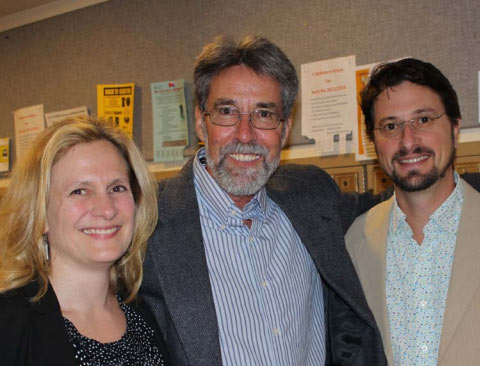
Professor Paul Hirt, an Environmental Historian from Arizona State University (in the middle) with two members of the CSD Advisory Board, Dr. Jennifer Cognard-Black, Professor of English (left) and Dr. Barry Ross Muchnick, Assistant Professor of Environmental Studies and Director of Environmental Citizenship Series.
In the 1960s, American cities were choked by air pollution and factories released pollutants directly into rivers and streams. Toxic chemicals made farmworkers sick and left children with life-long developmental problems. In comparison to these past times, the U.S. environment today is in relatively good shape, although much work remains to be done, according to Dr. Paul Hirt, a leading Environmental Historian from Arizona State University, during his visit to St. Mary’s College of Maryland (SMCM) on the September 17th Constitution Day.
How did we Americans manage to get back our blue skies and pristine streams? And what still needs to be done to keep these gains and prevent further environmental degradation?
Dr. Hirt believes that environmental protection needs active citizens who use the environmental rights and laws that past generations have fought for to preserve our fragile natural systems and our quality of life.
Dr. Paul Hirt’s Constitution Day lecture Not Such Strange Bedfellows: Environmental Advocacy and Democratic Reform was co-sponsored by the Center for the Study of Democracy, the Environmental Citizenship Lecture Series, and the Department of History. It was held on September 17th at SMCM. Dr. Hirt specializes in the American West, global environmental history, and environmental policy.
Hazy Skies and Rivers on Fire
The United States of the 1960s was a country where pollution was ever-present in most major cities. A few citizens challenged the prevailing view that the pollution was a price people had to pay for progress, as Dr. Hirt explained to students and faculty at St. Mary’s. Major cities suffered from smog, caused by emissions from sources such as coal-fired power plants, factories and smelters, and cars without catalytic converters.
It took the 1969 catastrophic fire of the Cuyahoga River in Ohio to alarm the general public about the environmental damage created by industrialization, Dr. Hirt explained. The Cuyahoga River that empties into Lake Erie became so polluted with industrial by-products that the river caught on fire multiple times during the twentieth century. But it was the 1969 fire that brought national attention to the issue of environmental pollution. The public outcry and the birth of grassroots environmental activism from this environmental disaster helped the country pass several key pieces of federal regulations to clean up our water, air, and land, such as the Clean Water Act of 1972.
Environmental Activism
Over the past 40 years, the United States has made remarkable progress in reducing pollution and protecting the environment. Many key pieces of legislation were adopted in the 1970s. These include the National Environmental Policy Act of 1970, the Clean Air Act of 1970, the Clean Water Act of 1972, the Endangered Species Act of 1973, and the Resource Conservation and Recovery Act of 1976. Many of these laws and environmental initiatives were among the first of their kind in the world.
The legislation that eventually resulted in a better environment within the United States was not passed without considerable pressure from ordinary citizens who used the rights they have in a democratic political system to petition their lawmakers, noted Dr. Hirt. Thanks to these activists, we breathe better air, drink cleaner water, and eat safer food. Dr. Hirt himself was involved in wilderness preservation and sustainable natural resources management activities during the 1980s and 1990s.
But laws alone don’t reduce environmental pollution. They must be implemented. That, explained Dr. Hirt, is often a long road full of struggles against special interest groups. To ensure that environmental laws actually make a difference, more pressure and follow-up by ordinary people and the non-governmental organizations that represent their views is needed.
From Environmental Democracy to Environmental Justice
Environmental democracy involves the principle of equal rights for those who are affected by environmental issues and policies. It also includes the public’s rights to information and participation in decision-making, explained Dr. Hirt. People who are concerned about the quality of the environment have fought hard to get these rights. They exist to be used and enforced by all citizens. In many countries, including China, there are no such rights or they are not implemented.
The existence of environmental rights is not a guarantee that they are used and applied uniformly across different communities and different parts of the country. In fact, for a long time environmental protection policies served primarily the interests of the affluent and well-educated members of society, explained Dr. Hirt. The poor and marginalized groups were left outside the movement and often suffered from exposure to dirtier water and air, more toxic soils, and other environmental hazards that affluent neighborhoods protected themselves against.
Little by little, environmental activism became more inclusive. In the 1990s, the concept of environmentalism expanded to cover environmental justice that refers to fair treatment and meaningful involvement of all people as part of the development, implementation, and enforcement of environmental laws.
Good Citizenship for the Sake of Environment
Environmental activists of the 1960s succeeded in bettering the natural environment for years to come because Americans believed in the power of ordinary people to influence government policy, Hirt explained. This belief may not be as strong today, but members of the younger generation have better tools at their disposal to make difference, such as the requirement to involve citizens in decision making and the rights of citizens to be informed about hazards in their workplaces and communities. By using these tools, everyone may exercise environmental stewardship for the benefit of the environment and his or her own well-being.
Professor Paul Hirt is the author of both The Wired Northwest: The History of Electric Power as well as Northwest Lands, Northwest Peoples: Readings in Environmental History
